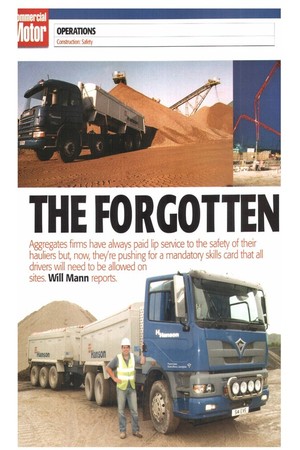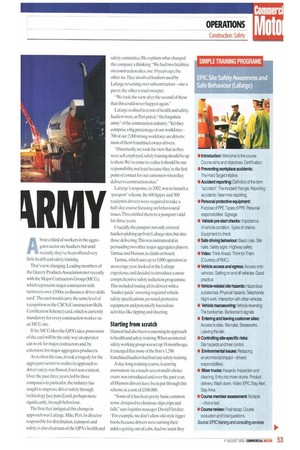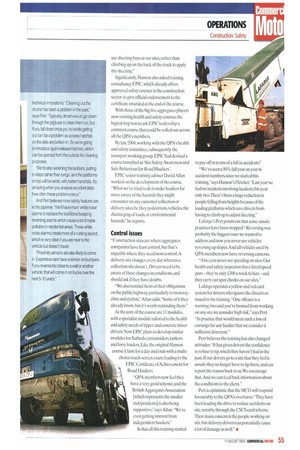THE FORGOTTEN tRIVIY
Page 52

Page 53

Page 55

If you've noticed an error in this article please click here to report it so we can fix it.
Aggregates firms have always paid lip service to the safety of their hauliers but, now, they're pushing for a mandatory skills card that all drivers will need to be allowed on
sites. Will Mann reports. About a third of workers in the aggregates sector are hauliers, but until recently, they've been offered very little health and safety training.
That's now changing. Leading members of the Quarry Products Association met recently with the Major Contractors Group (MCG), which represents major contractors with turnovers over £300m, to discuss a 'driver skills card'.The card would carry the same level of recognition as the CSCS (Construction Skills Certification Scheme) card, which is currently mandatory for every construction worker on an MCG site.
If the MCG likes the QPA's idea, possession of the card will be the only way an operator can work for major contractors and, by extension, for major aggregates producers.
As is often the case, it took a tragedy for the aggregates sector to realise its approach to driver safety was flawed, if not non-existent. Over the past three years, led by three companies in particular, the industry has sought to improve driver safety through technology [see panel] and, perhaps more significantly, through behaviour.
The firm that instigated this change in approach was Lafarge. Mike Pert, its director responsible for distribution, transport and safety, is also chairman of the OPA's health and safety committee. He explains what changed the company's thinking:"We had two fatalities on construction sites, one 10 years ago, the other six.They involved hauliers used by Lafarge reversing over subcontractorsone a paver, the other a road sweeper.
"We took the view after the second of these that this could never happen again."
Lafarge realised in terms of health and safety, hauliers were, as Pert puts it."the forgotten army" of the construction industry."Yet they comprise a big percentage of our workforce 700 of our 2,000 strong workforce are drivers; most of them franchised owner-drivers.
"Historically, we took the view that as they were self employed,safety training should be up to them.We've come to realise it should be our responsibility, not least because they're the first point of contact for our customers when they deliver to construction sites."
Lafarge's response, in 2002, was to launch a 'passport' scheme. Its 400 tipper and 300 readymix drivers were required to take a half-day course focusing on behavioural issues.This entitled them to a passport valid for three years.
Crucially, the passport not only covered hauliers picking up from Lafarge sites, but also those delivering.This was instrumental in persuading two other major aggregates players. Tarmac and Hanson, to climb on board.
Tarmac, which uses up to 5,000 operators in an average year, looked at the Lafarge experience and decided to introduce a more comprehensive safety induction programme. This included issuing all its drivers with a 'haulier guide' covering required vehicle safety specifications, personal protective equipment and potentially hazardous activities like tipping and sheeting.
Starting from scratch Hanson had also been reassessing its approach to health and safety training. When an internal safety working group was set up 18 months ago, it emerged that none of the firm's 1,200 franchised hauliers had had any safety training.
A day-long training course, featuring assessment via a touch-screen multi-choice exam, was introduced and over the past year, all Hanson drivers have been put through this scheme at a cost of £100.000.
"Some of it has been pretty basic common sense, designed to eliminate slips, trips and falls," says logistics manager David Fletcher. "For example, we don't allow old-style rigger boots, because drivers were turning their ankles getting out of cabs. And we insist they use sheeting bays at our sites, rather than climbing up on the back of the truck to apply the sheeting."
Significantly. Hanson also asked training consultancy EPIC, which already offers approved safety courses in the construction sector, to give official endorsement to the certificate awarded at the end of the course.
With three of the big five aggregates players now running health and safety courses, the logical step was to ask EPIC to develop a common course that could be rolled out across all the QPA's members.
By late 2004. working with the QPA's health and safety committee, subsequently the transport working group, EPIC had devised a course launched as 'Site Safety Awareness and Safe Behaviour for Road Hauliers'.
EPIC senior training adviser David Allan worked on the development of the course. "What we've tried to do is make hauliers far more aware of the hazards they might encounter on any customer collection or delivery sites. be they pedestrians, vehicles, the discharging of loads, or environmental hazards," he reports.


































































































































































































